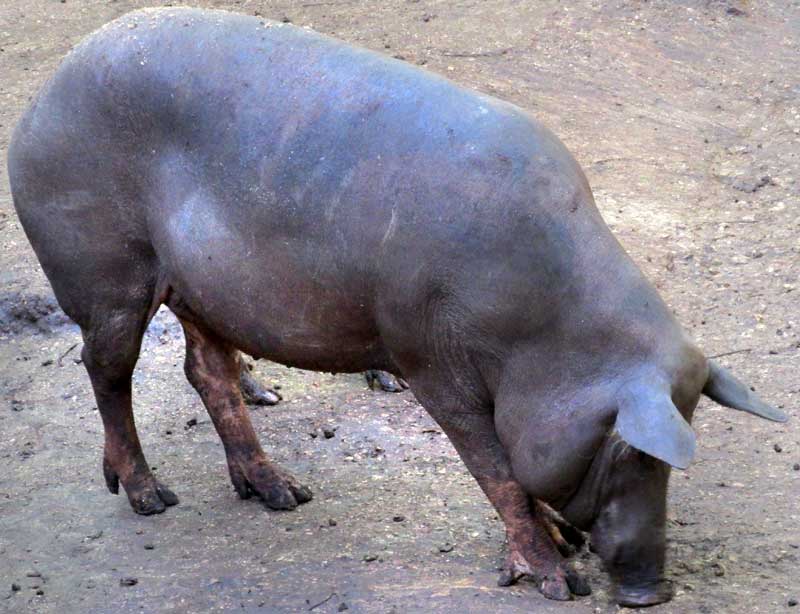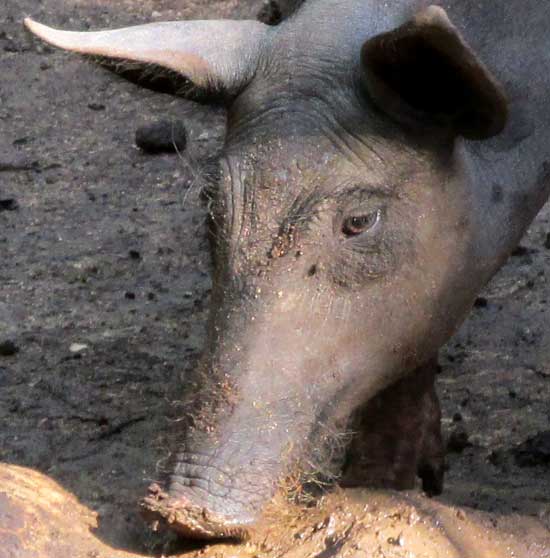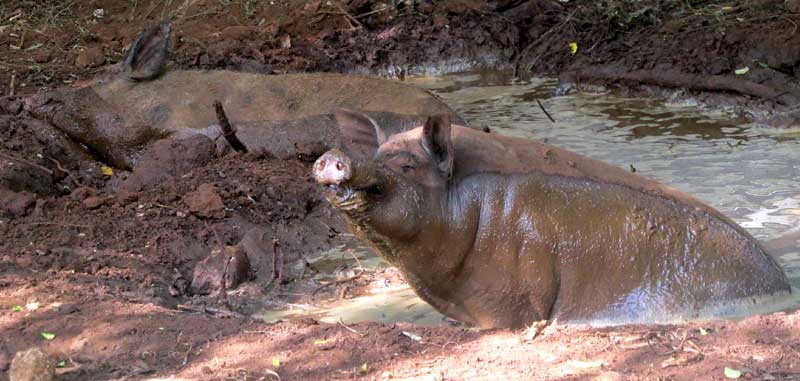Excerpts from Jim Conrad's
Naturalist Newsletter
from the December 25, 2016 Newsletter issued from Rancho Regenesis in the woods ±4kms west of Ek Balam Ruins; elevation ~40m (~130 ft), N20.876°, W88.170°; north-central Yucatán, MÉXICO
BLACK IBERIAN PIGS
I bet that nowhere in Mexico is there a herd of pigs as pampered as those here at the rancho. They've grown up as the owner's pets, with no worries about eventually being eaten. They're unlike pigs normally seen in the North, as shown below:

The two most obvious features distinguishing that pig from most others are its hairlessness and long snout. A portrait featuring the long snout is shown below:

This is a Black Iberian Pig, a special breed of the domestic pig, SUS SCROFA, native to the Iberian Peninsula -- Spain and Portugal. Its origins are unclear but the most commonly accepted theory is that the first pigs of any kind were brought to the Iberian Peninsula by the Phoenicians from what's known today as Lebanon. Once in their new home they interbred with wild boars, which gave rise to the ancestors of what are today Iberian Pigs.
Back when I traveled frequently in Spain, several times I unwillingly insulted hosts who proudly offered vegetarian-me slices of Spain's famous cured ham. The slices were exceedingly thinly cut with unusually red flesh marbled throughout with white, intramuscular fat. Those who ate the ham assured me that the taste was exceptionally good, with my hosts explaining that this was because the pigs ran wild in the country's oak forests feeding on acorns. The pigs had to move about a lot to find enough acorns to sustain them, so many acorns' sweetness was distilled into their flesh. It takes about an acre of oak woodland to support one pig.
Black Iberian Pigs are found here because the breed is known to do well in tropical climates. The breed's numbers have plummeted since 1960 because of African swine fever and society's general drift away from foods rich in animal fats, though in recent years they've been coming back because of a growing demand where there's less interest in healthy eating.
Not all Iberian Pigs are black; they can be red or of a hue ranging from gray to black.
An interesting feature of Iberian Pigs is that in their traditional habitats -- the oak forests of southern and central Spain and Portugal -- they're described as contributing decisively to the preservation of the ecosystem. I'm guessing that the contribution is that of "tilling the soil" with their rooting.
The oaks, in turn, help sustain their pig populations by way of the various oak species dristributing their acorn production over most of the year. From September almost to April three oak species, the Spanish, Gall and Cork Oaks drop their acorns, while the Holm Oak drops a particularly heavy crop from November to February.
from the August 23, 2018 Newsletter issued from Rancho Regenesis in the woods ±4kms west of Ek Balam Ruins; elevation ~40m (~130 ft), N~20.876°, W~88.170°; central Yucatán, MÉXICO
WALLOWING PIGS
If you want to see a couple of contented pigs, look below:

The rancho hosts about 40 Iberian Pigs, which aren't sold or killed for food. The owner just likes to have them. Possibly they enjoy the best lives of any pigs in Mexico. Now that the rainy season has begun and their holes stay full of water, they spend a lot of time doing exactly what's shown in the picture.
Why do pigs wallowing in mud holes so much? In our hot climate it's definitely a cooling experience. Pigs lack functional sweat glands, and are almost incapable of panting, so mud wallowing is an obvious cooler-offer. However, even during our rare northers in February or so, when I'm obliged to put on a shirt and long trousers, you see them wallowing with as much gusto as during the hottest day, so there must be other reasons.
At the root of the wallowing urge may be that pigs are related to hippopotamuses and whales, so that might lie behind their general urge to be in shallow, murky water.
Also, a layer of mud provides sunscreen, and surely helps keep horseflies from biting. Sometimes it's hard to spot the muddy pigs because they're the same color as other mud around them, so maybe their ancestors benefited from this camouflage effect, and evolved predispositions for mud baths.
During the dry season when their wallowing holes sometimes dry up, their pen didn't stink as it does now. I think they must poop in their wallowing holes, and maybe that protects them from predators, or at least makes them feel that they smell good.
When they exit their holes and the mud dries on their skin often they very vigorously rub themselves against tree trunks or rocks, and probably this knocks off ticks and other skin parasites that get dried into the caked mud.
Whatever their reasons for wallowing, each time I pass by their pen and see how contented they look, it makes me feel good just seeing someone enjoying themselves so much.